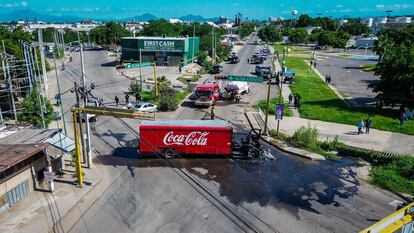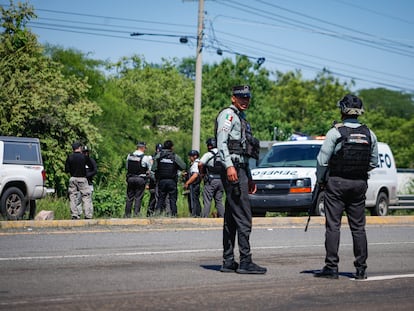Life stops in Sinaloa amidst war between El Mayo and Los Chapitos
Residents of the Mexican city of Culiacán tell EL PAÍS about the days of fear and uncertainty triggered by the fracture within the Sinaloa Cartel, which has left a trail of murders, disappearances and blockades
Every morning, Yazmín feels something in her chest that she finds difficult to describe. She gets in her car to start the day, while her daughter stays home. For the past week, she hasn’t wanted to take her little girl to school.
“I feel more at ease leaving her locked up with the neighbor, instead of having to take her across Culiacán. But I go to work wanting to cry, not because of what might happen to me, but because I don’t know if I’ll see her again,” she tells EL PAÍS, on the condition that her real name not be published. “But I don’t cry,” the civil servant clarifies. “We work for the government and they haven’t given us permission to miss work. The life insurance they give me is worth less than 100,000 pesos [$5,000]. I keep thinking about what I’m going to leave her… what I’m going to leave my daughter. You don’t feel protected or supported. You literally feel nothing,” she laments, on the other end of the phone.
The Mexican state of Sinaloa has been plagued by violence and insecurity since Monday, September 9, when an internal war broke out between the two most powerful factions of the notorious cartel: the followers of Ismael “El Mayo” Zambada, versus Los Chapitos, the sons of Joaquín “El Chapo” Guzmán. The fracture has sown chaos in Culiacán — the capital of the state in the northwest of Mexico — and in several surrounding communities, leaving a trail of murders, forced disappearances, blockades by drug traffickers and clashes between criminal groups and the Armed Forces. Caught in the crossfire, the population has sunk into fear and uncertainty, despite the government’s insistence that “everything is calm” and under control.
Last week, the authorities acknowledged that at least 12 people have been killed, another dozen have been injured by bullets, while around 20 have disappeared. Still, they maintain that the violence is concentrated in certain areas and mainly affects factions fighting over the principal bastion of the Sinaloa Cartel.
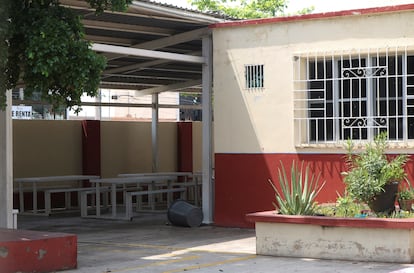
“They’re abducting innocent people,” says María, a psychologist who lives in the north of Culiacán, one of the hot spots for drug violence. Last Monday, she notes, one of her acquaintances disappeared without a trace. His car was abandoned on one of the city streets. “They mistook him for someone else and grabbed him,” she say. “He was missing for more than 20 hours, but at night, they told me they had found him… that he was scared, but fine.” María affirms that she has recognized other people in the missing persons reports that have been released over the past week. “There are many people who haven’t appeared and who haven’t returned. We don’t know if they’ll come back,” she adds.
Violence has disrupted the lives of the inhabitants of Culiacán. Most people are afraid to go out to work, take their children to school, or buy something in a store. “It’s as if we’ve returned to the pandemic: from 7 p.m. onwards, you’ll find the main streets emptier. It’s become an informal curfew,” María says. “There’s a collective psychosis: anxiety attacks, insomnia, stress, a fairly strong sense of fear... we weren’t prepared for this.”
Many families turn to their phones to report where they are and what they’re going to do, as well as to share information about what has happened in the last few hours. On social media, criticisms of the government, explicit images of crimes and reports of new clashes and blockades — some real and others false — are multiplying. At the beginning of the week, official information was scarce, or downplayed the extent of insecurity. All of this was exploited by the drug traffickers, who capitalize on the fear that they instill in the population.
“The authorities are on the back foot; the ones who set the tone are the criminal groups,” says David Saucedo, a security analyst, in an interview with EL PAÍS. President Andrés Manuel López Obrador has acknowledged that the violence broke out because “there are fights between two groups,” but he also accused the media of “magnifying” the situation for the sake of “sensationalism.”
“Tell the people of Culiacán, of Sinaloa, that we have enough [of a security] presence to guarantee peace [and] tranquility,” the president affirmed.

The beginning of the war
Culiacán is no stranger to violence. “Everything is tainted by drug trafficking in Sinaloa,” said Ana Luz Ruelas — professor emeritus at the Autonomous University of Sinaloa — in a conversation with EL PAÍS last month. Despite the normalization and permanent reach of organized crime, some episodes of violence have remained etched in the collective imagination. The Sinaloa Cartel rained fire in early-2023, following the capture of Ovidio Guzmán, son of El Chapo. “El Ratón” (“the mouse”) — as the 34-year-old capo is known — had already been arrested in 2019. But a violent response from the cartel — which included prison riots, illicit checkpoints on major highways and murders — led the authorities to decide to let him go, so as to avoid further damage.
The latest war to ravage the state emerged following the unexpected capture of El Mayo and Joaquín Guzmán López — Ovidio’s older brother, otherwise known as “El Güero” — on July 25, in the United States. Zambada accused El Güero — his godson — of betraying him, ambushing him and handing him over to the U.S. authorities, after summoning him to a meeting with Governor Rubén Rocha and political leader Héctor Cuén. Cuén was killed that same day. Rocha has denied having been present.
After that, fears soared regarding El Mayo’s revenge: when it would come and whether it would involve another Culiacanazo, the word used to describe the outbreaks of violence that followed the two captures of Ovidio Guzmán.
“It’s been worse before, [but] it’s never lasted so long,” explains Karla, a resident of the municipality of Costa Rica, south of Culiacán. On the morning of Monday, September 9, a confrontation on the main access road to that community resulted in two injured civilians and 15 bullet-ridden vehicles. On Tuesday night, the body of a decomposing person was found on the side of a road. On Wednesday, there was another scuffle between the security forces and “armed civilians,” the description used by the authorities to subtly refer to the cartels. On Thursday, the suspension of school activities in four municipalities — Culiacán, Elota, Cosalá and San Ignacio — was decreed for the rest of the week. “The narrative of the state authorities declares ‘tranquility’ and minimizes the violent events. They don’t understand that, after the capture of El Mayo, the entire context of Sinaloa changed: people have been waiting for the ‘war’ since then,” Adrián López, director of the newspaper Noroeste, posted on social media.
“Four hours ago, I went out to buy tortillas at a store that’s half-a-mile from my house. When I turned the first corner, I saw three patrol cars. I didn’t know if they were cloned by the criminals, or actually belonged to the police. I froze: I didn’t know what to do or where to go,” Karla recalls, in an interview with EL PAÍS. “The sound of the bullets makes your skin crawl… some were bursts, others were intermittent. It was chaos. I’ve heard gunshots before, but not on this scale,” she adds. “What we’re experiencing is like a horror movie.”
Karla understands both sides of the interruption of school activities: she’s a teacher and a mother. Like Yazmín, she’s decided that her daughter should stay home. The local Education Department has been the target of criticism from teachers and parents, first ordering the suspension of classes in one of the city’s sectors, then announcing a broader cancellation with little notice. After initially pushing for a return to in-person classes, the department finally resigned itself to postponing classes for another week.
The Autonomous University of Sinaloa — which has 70,000 students throughout the state — has opted for virtual classes. Still, problems persist. “Many students come from rural areas and don’t have internet access. Others don’t have credit on their phones, because their families haven’t been able to go out to work,” Karla explains. “We cannot demand that they go look for an internet cafe to send in their assignments… we cannot expose them to any risk.”
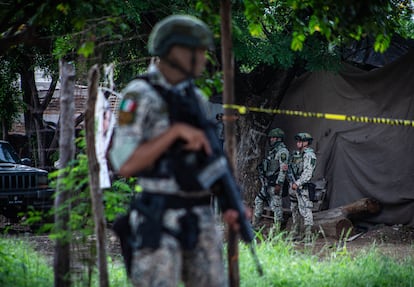
Governor Rocha asked retailers to open their businesses, after the local branch of the National Chamber of Commerce warned that there were no minimum security conditions to avoid the paralysis of the local economy. The Union of Retailers of Culiacán estimates that the economic losses due to violence are over 800 million pesos ($40 million), while warning about a shortage of basic products. The local Union of Tenants estimates that 2,000 workers have resigned due to the violence, just in the center of the city.
Oxxo — the largest chain of convenience stores in Mexico and Latin America — announced that it was going to take extreme measures to guarantee the safety of its employees and hoped that “security conditions in the state would be restored to resume normal operations.” Aeromexico announced a flexible policy to change flight schedules and routes to and from Culiacán. Coparmex — the country’s main employers’ association — denounced the lack of action by the authorities and demanded greater security guarantees amid the violence. The governor opted to cancel a concert in the city’s main public square for the celebrations of Independence Day, on September 16. And the United States issued a travel alert, warning citizens not to visit the state. Those who do so are advised to “be aware of [their] surroundings” and “maintain a high level of vigilance and keep a low profile.”
Old allies and new rivals
After El Chapo’s extradition to the United States in 2017 and his life sentence being handed down in 2019, four of his sons stepped up in the business. Los Chapitos undertook an aggressive expansion strategy and moved away from the discreet style of other factions, such as the one led by El Mayo. Zambada made few public appearances in recent years, although, before his capture, he imposed — with an iron fist — a strict criminal governance in his territories, stretching out a wide network of corruption that allowed him to avoid jail for five decades. Guzmán’s heirs are considered to be a much more impulsive group, prone to public displays of power and ostentation.
According to U.S. authorities, the Mayiza and the Chapiza — as both groups are known — have been at odds for years, but they coexisted under the same umbrella in the understanding that they were stronger together. “For more than 50 years, [the relationship] has been impeccable, respectful and harmonious, to the point that there are [guardianships] and marriages between both families,” said José Luis Rodríguez Meza — El Chapo’s lawyer — at the end of July.
The capture of El Mayo changed everything. Amid the tensions and despite Zambada’s calls for calm from prison, a dozen members of the Mayiza were killed in the weeks before hostilities intensified. Mausoleums of other bosses were desecrated and there were shootouts between “armed civilians” and the authorities. Security analysts, however, estimate that the firepower and presence of Zambada’s group had been declining since before his arrest, compared to the better-armed and more powerful Los Chapitos. One of the hypotheses explaining the delayed outbreak of violence is that Ismael Zambada Sicairos — alias “Mayito Flaco,” the supposed successor to his father — postponed revenge to have time to arm himself and seal strategic alliances.
A source linked to the Mayiza assured the CrashOut Media website that Mayito Flaco created a “war council” at the beginning of September with two new partners: José Gil Caro Quintero — nephew of the notorious Rafael Caro Quintero — and Isidro Meza Flores. Both are old enemies of El Chapo. According to this version, Flores’ people agreed to send 200 hitmen and Caro Quintero offered another 150 to “fumigate Los Chapitos.”
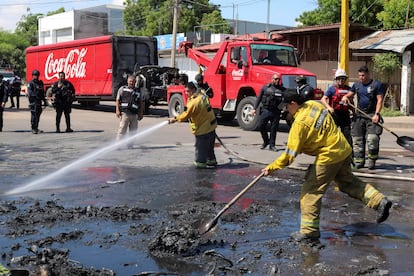
Today, the focus isn’t only on Sinaloa. The outbreaks of violence have spread to other states. Local populations are on tenterhooks to see how the Jalisco Nueva Generación Cartel (CJNG) — the main rival of the Sinaloa Cartel — will move its pieces. Another possibility is that Los Chapitos will go on the offensive and seek to wipe out their adversaries, in order to take control of the entire criminal organization. There are also pending trials: El Chapo fell after the testimony in court of Jesús “Rey” Zambada and Vicente “Vicentillo” Zambada — brother and son of El Mayo — as well as other former collaborators.
The authorities have acknowledged that the conflict exists and will continue, but haven’t given public explanations about it. “It’s a matter [to be resolved between the cartels]... [they must ensure] that they don’t affect the population and that they also take care of themselves,” President López Obrador declared on Friday. He trusts that the arrival of hundreds of reinforcements from the Armed Forces will quell the violence. But the “matter” affects everyone.
“Even if you don’t want to find out or don’t know much about the Mayiza or the Chapiza, it’s what everyone is talking about. We’re all thinking about what tomorrow will bring and when we’ll be able to have a normal life,” María laments. “The days have become eternal and the nights are super short. Suddenly, you open your eyes and it’s daylight again… and you don’t know what’s going to happen.”
Yazmín looks in the rearview mirror and side mirrors, speeding up to get to work faster. She trembles whenever a truck stops next to her. “You start to see shootings, missing people, dead people. And, suddenly, the government tells you that nothing’s happening. We all knew that the atmosphere was tense, that at some point the war was going to happen.”
While the crossfire besieges Sinaloa, the United States has announced the transfer of El Mayo to the Eastern District Court of New York, the same one where El Chapo — his former ally — was convicted five years ago.
Sign up for our weekly newsletter to get more English-language news coverage from EL PAÍS USA Edition
Tu suscripción se está usando en otro dispositivo
¿Quieres añadir otro usuario a tu suscripción?
Si continúas leyendo en este dispositivo, no se podrá leer en el otro.
FlechaTu suscripción se está usando en otro dispositivo y solo puedes acceder a EL PAÍS desde un dispositivo a la vez.
Si quieres compartir tu cuenta, cambia tu suscripción a la modalidad Premium, así podrás añadir otro usuario. Cada uno accederá con su propia cuenta de email, lo que os permitirá personalizar vuestra experiencia en EL PAÍS.
¿Tienes una suscripción de empresa? Accede aquí para contratar más cuentas.
En el caso de no saber quién está usando tu cuenta, te recomendamos cambiar tu contraseña aquí.
Si decides continuar compartiendo tu cuenta, este mensaje se mostrará en tu dispositivo y en el de la otra persona que está usando tu cuenta de forma indefinida, afectando a tu experiencia de lectura. Puedes consultar aquí los términos y condiciones de la suscripción digital.
More information
Archived In
Últimas noticias
Most viewed
- Sinaloa Cartel war is taking its toll on Los Chapitos
- Oona Chaplin: ‘I told James Cameron that I was living in a treehouse and starting a permaculture project with a friend’
- Reinhard Genzel, Nobel laureate in physics: ‘One-minute videos will never give you the truth’
- Why the price of coffee has skyrocketed: from Brazilian plantations to specialty coffee houses
- Silver prices are going crazy: This is what’s fueling the rally
